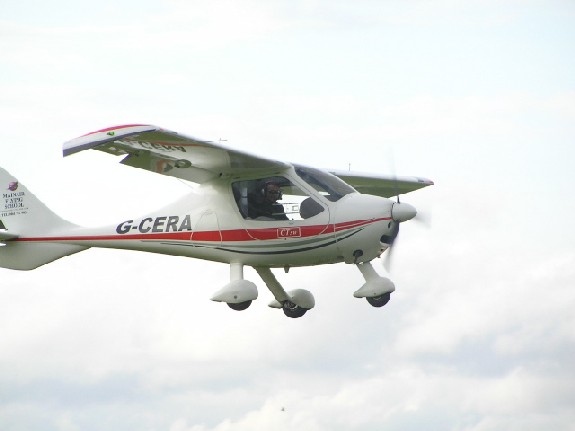
Mainair's Ikarus C42s
An interview with Chris and Marcus of Mainair Flying School. We’ll be discovering the world of microlights and finding out just how far they’ve come in the last few years. I was certainly quite surprised at just how high-tech this new breed of light aircraft have become. Microlighting should be a definite contender if you are thinking of learning to fly or are looking for something to put the fun back into your aviation career.
 Listen to Episode 4
Chris Copple, MD of Mainair Microlight School and one of his instructors, Marcus Furniss, talk to us today about the world of microlight aviation.
Mainair started out as a manufacturer of microlights in Rochdale. In 2003 they sold the manufacturing side of the business to Pegasus in Wiltshire and Chris took over the microlight school at Barton Airport.
Mainair are mostly involved in the fixed wing microlight training area, teaching to the NPPL standards.
In addition to instructing, Chris also sells the Ikarus C42 and Flight Design CTSW aircraft and sets up syndicates for interested flyers.
The new breed of fixed wing microlight are very hi-tech, hi performance aircraft and offer a flying experience similar to class A GA aircraft.

Fly Design CTSW
The microlight is defined by it’s MAUW (maximum all up weight) of 450kg, minimum stall speed of 35kts and a wing loading of 25kgs/sq metre or less.
Marcus explains that modern microlights are very safe, or as safe as the pilot that flies them and with hi-tech 4 stroke Rotax engines, for example, they are very reliable.
Fuel consumption can vary between 10 and 15 litres per hour and run on unleaded fuel so they are pretty economical too.
From most angles, microlight aviation make very good sense.
Learning to fly microlights at Mainair is hopefully about fun in addition to the obvious safety aspects.
The NPPL syllabus consists of a minimum of 25 hours flying, the same written exams as the JAA PPL licence and the medical is available by getting your GP to sign you off as being fit to fly.
Trial flights are available to see if you enjoy microlighting, either flexwing or fixed wing. Check the web site for details of current costs.
Chris and Marcus explain the differences between fixed wing and flex wing aviation, the sort of equipment you may require and the advantages of each type of flying.
Mainair have 2 Ikarus C42 aircraft. They are a mix of metal tube, composite fuselage and fabric covered wing construction with a flying duration of 4-4.5 hours. Chris actually flew this aircraft from John o’Groats down to Land’s End and back in 1 day!
This is the main aircraft that they use for flight training and having been up in one myself, I can vouch for its very benign handling.

Ikarus C42
The Fly Design CTSW has a more ‘sporty’ performance and I found it a little more demanding to fly. Their aircraft has a 100hp Rotax engine and hence cruises faster – at up to 115kts – and has a range of around 1000 miles.
Both aircrafty have extremely short take-off distances meaning that they can be operated from farm strips.
The only downsides I could see are the weight issues which are imposed by legislation. These microlights are always a trade off between fuel, passengers, luggage and trying to stay within the 450kg limit.

Fly Design CTSW
With the lower operating costs and less onerous legislation, microlighting makes more and more sense. As in the USA with its Light Sport Aviation segment Chris is expecting the laws to change in the Europe to benefit the microlight aviation market.
Once you have your NPPL (Microlight) you can progress to NPPL or a full PPL with the hours you have gained in a 3-axis control microlight contributing to the hours required for the more advanced license.
So if you want to experience the world of microlight aviation, give Chris a call on 0161 787 9034. Further details are on the Mainair web site.
